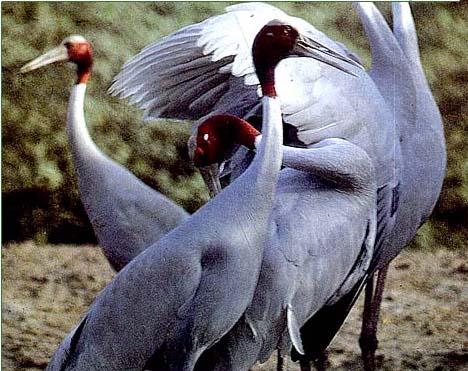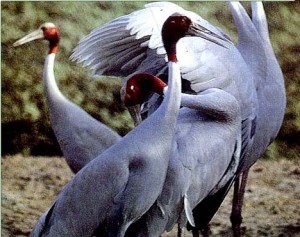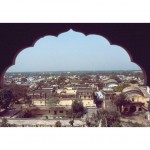Bharatpur is the place that would surely answer your question as to why Dr Salim Ali was so fascinated with birds Period. It’s not the beauty or the variety but sheer enormity of the region and the ease with which the birds have accepted this meagre offering from us human makes Bharatpur area and its surroundings a paradise to visit.
Prince Bhamji of Morvi (Gujarat) was instrumental in mooting the idea and implementing it by converting this area into a wildlife reserve. It was a common practice to organize Duck shoots almost every year in honour of Viceroy Lord Curzon. Bharatpur used to be one of the most important princely states located on the edges of Thar Desert. The land being marshy was always conducive for birds and animals searching water to quench their parched lips and throats. The best part about Bahartpur is the location of the place which is very convenient for tourists from many states to access it. The area being a part of desert experiences extreme climates. This land of the Rajputs tells many stories of braveries against the attacks by Mughals and the British. The area is also famous for the forts, palaces and the Mughal and Rajput architecture visible almost everywhere. The Land, its people and the architecture tell an impassive story about these fighters who survived and flourished in these hostile conditions. Bharatpur is also known as Lohagarh. Bharatpur is famous for its sweets which are well prepared here and there are a large number of shops here.
There are more than 50 oil mills in Bharatpur due to mustard grown in large quantity in the surrounding areas.
Bharatpur is a city in the Indian state of Rajasthan. It was founded by Maharaja Suraj Mal in 1733. Located in the Brij region, Bharatpur was once an impregnable, well-planned and well-fortified city, and the capital of Jats kingdom ruled by Sinsinwar Maharajas.The royal house of Bharatpur has a history from the 11th century and claims their descent from the Yadavs . The trio of Bharatpur, Deeg and Dholpur has played an important part in the history of Rajasthan. Located 55 km west of the city of Agra (the city of the Taj Mahal) and 35 km from Mathura, it is also the administrative headquarters of Bharatpur District and also the headquarters of Bharatpur Division of Rajasthan. The Royal House of Bharatpur traces their history to the 11th Century AD. of this region are of most respected royal status in Rajasthan.
History
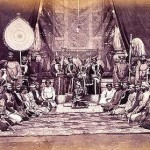 The history of Bharatpur has immediate correlations with the history of Rajasthan. The town was named Bharatpur after Bharata, a brother of Lord Rama, whose other brother Laxman is the family deity of the erstwhile royal family of Bharatpur. The city and the fort of Bharatpur have been believed to be founded by Maharaja Surajmal in the early seventeenth century. He established a state in the Braj region south of Delhi, with its capital at Deeg. Leaders such as Gokula, Raja Ram, Churaman and Badan Singh brought together all the Jats and moulded them into a force to be reckoned with. Maharaja Suraj Mal was the state’s greatest ruler; he made the state a formidable force in the region. During the British Raj, the state covered an area of 5,123 km² and its rulers enjoyed a salute of 17 guns. The state acceded unto the Dominion of India in 1947. It was merged with three nearby princely states to form the “Matsya Union”, which in turn was merged with other adjoining territories to create the present-day state of Rajasthan.
The history of Bharatpur has immediate correlations with the history of Rajasthan. The town was named Bharatpur after Bharata, a brother of Lord Rama, whose other brother Laxman is the family deity of the erstwhile royal family of Bharatpur. The city and the fort of Bharatpur have been believed to be founded by Maharaja Surajmal in the early seventeenth century. He established a state in the Braj region south of Delhi, with its capital at Deeg. Leaders such as Gokula, Raja Ram, Churaman and Badan Singh brought together all the Jats and moulded them into a force to be reckoned with. Maharaja Suraj Mal was the state’s greatest ruler; he made the state a formidable force in the region. During the British Raj, the state covered an area of 5,123 km² and its rulers enjoyed a salute of 17 guns. The state acceded unto the Dominion of India in 1947. It was merged with three nearby princely states to form the “Matsya Union”, which in turn was merged with other adjoining territories to create the present-day state of Rajasthan.
The Jat rulers of Bharatpur were from Sinsinwar clan of Jat people Which is indo-sythian tribe migrated in India. According to Cunningham and William Cook, the city of Gohad was founded by the Jats of Bamraulia village, who had been forced to leave Bamraulia by a satrap of Firuz Shah Tughluq. Gohad developed into an important Jat state, and was later captured by the Marathas. The Jat people of Gohad signed a treaty with the British and helped them capture Gwalior and Gohad from the Marathas. The British kept Gwalior and handed control of Gohad to Jat people in 1804. Gohad was handed over to the Marathas under a revised treaty dated 22 November 1805 between the Marathas and the British. As a compensation for Gohad, the Jat ruler Rana Kirat Singh was given Dhaulpur, Badi and Rajakheda; Kirat Singh moved to Dhaulpur.
In the 10th century, the Jat people took control of Dholpur, which had earlier been ruled by the Rajputs and the Yadavs. Dholpur was taken by Sikandar Lodhi in 1501, who transferred it to a Muslim governor in 1504. In 1527, the Dholpur fort fell to Babur and continued to be ruled by the Mughals until 1707. After the death of the Mughal emperor Aurangzeb, Raja Kalyan Singh Bhadauria obtained possession of Dholpur, and his family retained it. After that, Dholpur was taken successively by the Jat ruler Maharaja Suraj Mal of Bharatpur; by Mirza Najaf Khan; by the Scindia ruler of Gwalior in 1782; and finally, by the British East India Company . It was restored by the British to the Scindias under the Treaty of Sarji Anjangaon, but in consequence of new arrangements, was again occupied by the British. In 1806, Dholpur again came under the Jat rulers, when it was handed over to Kirat Singh of Gohad. Dholpur thus became a princely state, a vassal of the British during the Raj.
Ballabgarh was another important princely state established by the Jat people of the Tewatia clan, who had come from Janauli village. Balram Singh, the brother-in-law of Maharaja Suraj Mal was the first powerful ruler of Ballabhgarh. Raja Nahar Singh was another notable king of this princely state.
Other Jat states of the eighteenth and nineteenth centuries included Kuchesar (ruled by the Dalal Jat clan of Mandoti, Haryana), and the Mursan state (the present-day Hathras district in Uttar Pradesh) ruled by the Thenua Jats.
The Jat people also briefly ruled at Gwalior and Agra. The Jat rulers Maharaja Bhim Singh Rana and Maharaja Chhatar Singh Rana (1757–1782) occupied the Gwalior fort twice, Maharaja Bhim Singh Rana from 1740 to 1756, and Maharaja Chhatra Singh Rana from 1780 to 1783. Maharaja Suraj Mal captured Agra Fort on 12 June 1761 and it remained in the possession of Bharatpur rulers till 1774. After Maharaja Suraj Mal, Maharaja Jawahar Singh, Maharaja Ratan Singh and Maharaja Kehri Singh (minor) under resident ship of Maharaja Nawal Singh ruled over Agra Fort.
Places to See in Bharatpur
Bird Sanctuary- Keoladeo National Park
A paradise for the avian world, and the pilgrimage for the bird lovers, it was known as the best duck shooting resort in the British empire. But was declared a reserve for birds in 1956 and later upgraded to National Park. UNESCO has listed it as a world heritage site.
The geographical location is ideal as it is on the main North – South avian route of India. Although small in size, 29 sq. km. only, it boasts to house more than 375 species of beautiful birds, and more than 132 of them breed inside the Keoladeo Ghana National Park and nearly every year new ones are added to the list. The sanctuary not only attracts birds from India but also from places like Europe, Siberia, China and Tibet.Before mansoon hundreds of these exotic birds roost and nest building activities start on the babool and kadam trees of the park. Water coming through the Ajan Bandh starts filling the various ponds and lakes of the Park. When assured of enough food, hundreds of large, medium and little cormorant, darter, purple and Grey heron, various species of egret, painted, open-billed, white necked and black necked stork, white ibis, spoonbill, night heron and other birds get busy in courting and mating. The trees are over flowed with nests, one can observe a tree housing nests upto fifties and sixties in number belonging to different species of birds looking after their loving young ones. The nests on the trees look like pearl necklaces.
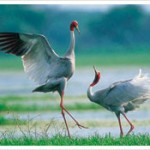 cordial Saras cranes, the tallest flight birds nest in exposed and open area, both of the partners share the duty of hatching, while chanting incubating duties, they come together, raise their neck and give out piercing trumpetic calls in unison and at the same time fan their feathers. Their newly born chicks are only 10 cm. in size but they grow upto one meter in height within a year.
cordial Saras cranes, the tallest flight birds nest in exposed and open area, both of the partners share the duty of hatching, while chanting incubating duties, they come together, raise their neck and give out piercing trumpetic calls in unison and at the same time fan their feathers. Their newly born chicks are only 10 cm. in size but they grow upto one meter in height within a year.
On the monsoons arrival birds from every part of the country start driving into the park. Migratory water-fowls, including the pride of Keoladeo Siberian Cranes form the vital part of Park. The water-fowls visit the park in millions during October. The most noticeable water-fowl coming to the park are bareheaded and greylag geese. The ducks spotted here are pintail, common teal, ruddy shelduck, mallard, widgeon, common shelduck, red crested pochard, gadwall etc. predatory birds like imperial eagle, steppe and tawny eagle spotted eagle, marsh harrier and laggar falcon are attracted towards the park completing the food chain of the ecosystem. Some of them like short-toed eagle, lesser spotted eagle and shikra are the residents of Park.
About 11 sq. km. area of the park is covered with water the remaining portion is rich with Kingfisher, Red Vented and white cheeked Bulbuls, Babblers, Quails, Partridges, Sunbirds, Sparrows and Parakeets which live in bushes and burrows. The year round activity of the winged beauties has made the park a pilgrimage for bird lovers and an omithologists delight.
The animal populace also show their presence although they are thoroughly dominated by feathers, wings and beaks.  The animals include the Black Buck, Sambhar – the largest Indian Antelope, Spotted deer, and Nigais. Pythons can also be observed at some places lazing in the sun.
The animals include the Black Buck, Sambhar – the largest Indian Antelope, Spotted deer, and Nigais. Pythons can also be observed at some places lazing in the sun.
Vehicles are only permitted upto Shanti Kutir inside the park. The Electra Van of forest department can be engaged in the sanctuary, although the best way to explore the park is on foot or bicycles which are available on hire. Cycle rickshaws can also be hired.
Lohagarh Fort (Iron fort)
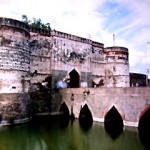 Lohagarh Fort (Iron fort) is situated at Bharatpur in Rajasthan, India. It was constructed by Bharatpur Jat rulers. Maharaja Suraj Mal used all his power and wealth to a good cause, and built numerous forts and palaces across his kingdom, one of them being the Lohagarh Fort(Iron fort), which was one of the strongest ever built in Indian history. The inaccessible Lohagarh fort could withstand repeated attacks of British forces led by Lord Lake in 1805 when they laid siege for over six weeks. Having lost over 3000 soldiers, the British forces had to retreat and strike a compromise with the Bharatpur ruler. Of the two gates in the fort, one in the north is known as Ashtdhaatu (eight metalled) gate while the one facing the south is called Chowburja (four-pillared) gate.
Lohagarh Fort (Iron fort) is situated at Bharatpur in Rajasthan, India. It was constructed by Bharatpur Jat rulers. Maharaja Suraj Mal used all his power and wealth to a good cause, and built numerous forts and palaces across his kingdom, one of them being the Lohagarh Fort(Iron fort), which was one of the strongest ever built in Indian history. The inaccessible Lohagarh fort could withstand repeated attacks of British forces led by Lord Lake in 1805 when they laid siege for over six weeks. Having lost over 3000 soldiers, the British forces had to retreat and strike a compromise with the Bharatpur ruler. Of the two gates in the fort, one in the north is known as Ashtdhaatu (eight metalled) gate while the one facing the south is called Chowburja (four-pillared) gate.
It is very different from the other forts in Rajasthan state, there is no flamboyance associated to fort but it generates an aura of strength and magnificence. The fort is surrounded with moat which was previously filled with water to ward off the enemy attacks. The sandy ramparts were strengthened by sandy battlements, thus the enemy guns proved of no avail.
Some interesting monuments in the fort are Kishori Mahal, Mahal Khas and Kothi Khas. Moti Mahal and towers like Jawahar Burj and Fateh Burj were erected to commemorate the victory over the Mughals and the British army . The Gateway has paintings of huge elephants.
Government Museum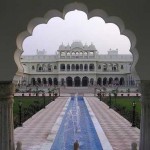
The Government Museum, Bharatpur is located inside the historic LohagarhFort which is about 4 Km. away from the main bus stand and railway station. The Kachahri Kalan andKamara Khas buildings built during the reign of Maharaja Balwant Singh in first half of 19th century A.D. In 1939, sculptures and other objects were collected from various places of the region and initially displayed in Public Library under the patronage of H.H Maharaja Sawai Brijendra Singh. These were shifted to the present building of Kachahri Kalan in 1944 A.D. and it was formally opened to public on 11th Nov, 1944. Later on the Kamara Khas building was added to it. It has rare and distinguished collection of sculptures, inscriptions, coins, arms and weapons and decorative art objects. The museum has in its possession above 4000 antiquities. The buildings which house the museum in itself are marvellous examples of artistic beauty. This museum is the repository of traditional artefacts, delicately carved sculptures and ancient inscriptions that speak a lot about the region’s cultural heritage.
Timings : 09.45 AM to 5.15 PM
Entry Fee :
Indians RS. 5/-
Indian Students RS. 2/-
Foreigners Rs. 50/
Foreign Students Rs. 25/
(Closed on Monday)
The Palace
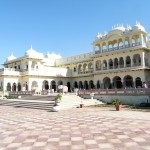 The magnificent imperial building reflects the fusion of Mughal and Rajpat architectural styles with majestic apartments and exquisitely designed floor tiles exhibiting fascinating patterns. The ancient exhibits displayed in the museum at the centre of the palace inspire awe of the beholder.
The magnificent imperial building reflects the fusion of Mughal and Rajpat architectural styles with majestic apartments and exquisitely designed floor tiles exhibiting fascinating patterns. The ancient exhibits displayed in the museum at the centre of the palace inspire awe of the beholder.
Places of Worship
Ganga Mandir, Laxmi Mandir , Jama Masjid ,St. Luke’s Church and Gurudwara.
General Facts
State Rajastan
Population 304,456(2001)
Area 29sq kms
Altitude 250m above sea level
Languages Hindi
Longitude 77° 30′ E
Latitude 27° 15′ N
Best time to visit October to march
Submit your review | |
